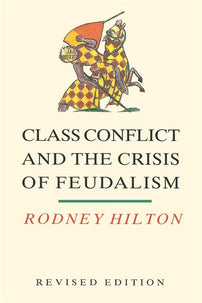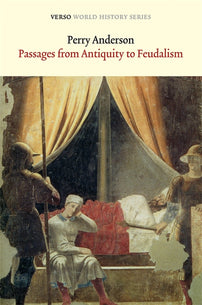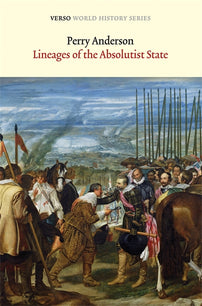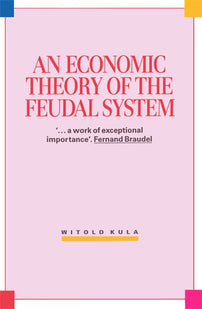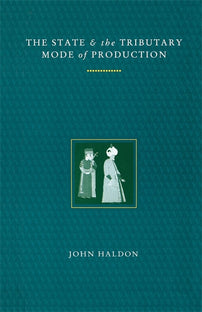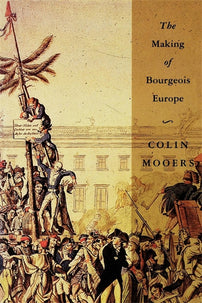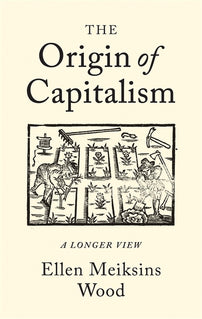Was there a General Crisis of Feudalism?
Was the feudal order subject to accidental disintegration; did it collapse under several unrelated crises; or was there a general crisis of this society because of its inherent weaknesses?
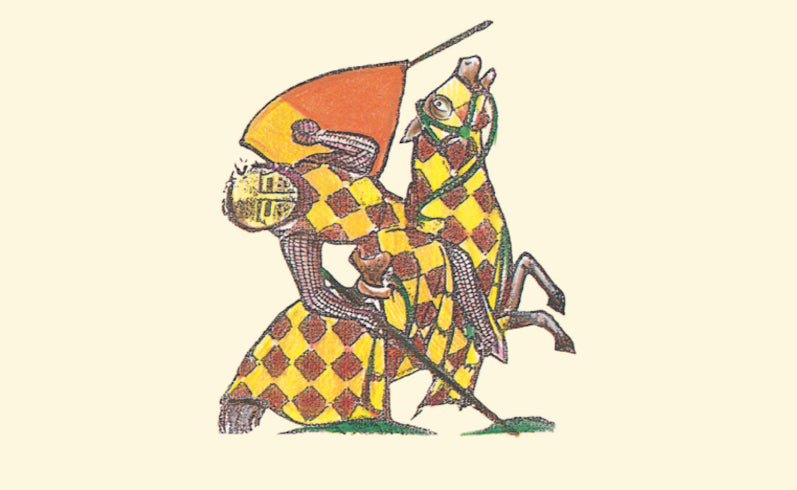
Class Conflict and the Crisis of Feudalism collects occasional essays by Rodney Hilton, the distinguished medievalist and scholar of the transition from feudalism to capitalism. First published by the Hambledon Press, Verso issued a revised edition in 1990. Hilton writes:
The title of this collection of articles reflects a theme in my historical research. My view has been that conflict between landlords and peasants, however muted or however intense, over the appropriation of the surplus product of the peasant holding, was a prime mover in the evolution of medieval society. I also think that the social and political crises of the late medieval feudal order cannot be understood if what Marc Bloch called "the crisis of seigneurial fortunes" is not seen as the consequence of a failure by the ruling aristocracies to keep up the level of appropriation. From the outset, I have tried to understand and to explain the considerable variations in the size, composition and management of landed estates. I have also (and particularly recently) attempted to investigate the nature of medieval urbanisation, a consequence of the development of both simple, local commodity production and long distance trade inespecially-luxury goods. This has been associated, of course, with an interest in the vexed problem of the medieval origins of capitalism.
The essay below was first published in French, appearing in Annales. Economies, sociétés, civilisations in 1951.
Contemporary historians are showing considerable interest in the end of feudal society and in the economic, social, and political factors which brought the modern world into existence. 1 There is nothing surprising in their efforts to understand why and how established social orders go through periods of crisis and in the end collapse. Even medievalists cannot expect to be sheltered from the world in which they live. It is quite natural, therefore, to ask oneself whether the feudal order was subject to accidental disintegration, to be gradually replaced by another social, economic and political order — capitalism; or whether its disintegration was speeded up by several unrelated crises, which operated in different aspects of feudal society; or whether there was, in fact, a general crisis of this society because of its inherent weaknesses — a general crisis of which the separate crises which historians examine were simply particular expressions.
E. Perroy, in his recent article in Annales on the crises of the 14th century, writes about some of the catastrophes which shook the social order of western Europe; he characterises this society by the end of the century as afflicted by "mediocrity in stagnation," rather as M. M. Postan, in an article on the 15th century, characterises the subsequent period. And it is, in fact, one of the surprising features to us of the decay of medieval society that it should have lasted so long, accustomed as we are to much quicker cycles of growth and depression. From the 14th century onwards, this civilization was undermined by intellectual doubts, its political foundations were sapped and it seemed to have become socially and morally decrepit. The general picture can be perceived, even though many details are obscure and although the sequence of cause and effect is by no means disentangled, especially as far as demography is concerned.
The European population, no doubt, increased considerably during the 12th and 13th centuries, but in the 14th century, before the Black Death, it was beginning to diminish. At the same time, that is before the Black Death, indications of crisis and decline appear in the most important sector of the economy, agriculture. Land went out of cultivation and that which was still tilled yielded less. There could be no more revealing indications of the crisis of a social order than the inability of its ruling class, demonstrated over a long period of time, to profit in a situation over which they seemed to have complete control. And yet, both the accounts of the great estates in England and the terms of contracts of tenure in France reveal, in the first half of the 14th century, the beginnings of a contraction of seigneurial revenues which lasted for at least a century.
Consequently, the principal market for imported goods in Europe, as well as for many of the continent's industrial products, also contracted. It is no surprise therefore that industry and commerce were affected by the crisis. Thus, underlying the violent but short term oscillations of the textile industry (attributable to political causes) a general tendency to contraction is to be seen. Commercial and financial companies scaled down their activities. Urban populations diminished. There appeared to be no recovery until the end of the Isth century.
One may wonder, however, whether the phrase of E. Perroy, quoted above, "mediocrity in stagnation," is altogether adequate to characterise western European society towards the end of the 14th and the beginning of the 15th centuries. The phrase certainly cannot be applied without risk of error to the whole of the 14th century, that epoch when society was rent, not only by warfare between states but by social conflicts on a scale hardly paralleled since the age of the Bagaudae. The revolts of maritime Flanders, of the Jacques in France, of the English peasants in 1381 and of the lower and middling strata in numerous Italian, French, Flemish, and English towns, are dramatic events which have to be situated in a climate of discontent which historians are only just beginning to study. The most interesting aspect of the major rebellions of the later middle ages is that they no longer simply expressed grievances against local oppression, they were becoming the expression of a revolt against the way society was organised. Whatever might be the differences between the risings of the French Jacques and the English peasants, they had this in common: a manifest hatred of the officials of the State, rather than of those of the manor or seigneurie who had been the traditional objects of peasant discontent. And, of course, even if lords became less involved in manorial production, they still had to cope with the problem of falling revenues. War and pillage were still among the measures used in their attempt to solve the problem but it was the State which organised war and raised the money needed to pay for it. State taxation was added therefore to the burden of rent owed by the peasant and urban taxes bore down on the petty artisans and wage workers of the towns.
To sum up, the profile of the late medieval crisis as it emerges from recent research is of a contraction of the rural and industrial economies operating over a long period and accompanied by a fall in the population. This contraction was probably felt in the first place by the ruling class, given the fact that even in periods of economic expansion the lower classes lived not far from famine conditions. Seigneurial revenues and industrial and commercial profits began to fall. Consequently wars which in the past had tended to stop soon after they began, were prolonged because their protagonists saw in them the chance to compensate by pillage and ransom for the fall in their rent. But the prolongation of these wars made the mobilisation of armies more difficult, complicated and costly, especially since military expeditions had to be paid for in cash rather than raised on the basis of military service. It was not only the burden of tax but the disorganization of the economy in the war zones which had to be borne by the poor, thus provoked to rebellion. Revolt in the towns disorganised industrial production and revolt in the countryside strengthened peasant resistance to the payment of rent. Rent and profits thus dropped even further — a vicious circle.
One has to ask however, how this process began? Was there a series of unconnected crises which shook the social order to the point at which, however basically sound, it was incapable of recovery? Or, on the contrary, were there deeper causes at the root of these economic, social, and political crises? This latter explanation seems to us the better. But let us put away one specious hypothesis: that there was some sort of slump in agriculture, industry, and finance, similar to those which our own experience of capitalist society suggests should be expected after a period of prosperity.
For here we do not have to deal with a capitalist society. The necessary conditions for such a society did not exist in 14th century Europe. By far the greatest proportion of the products of agriculture and even of industry were always intended for the consumption of the producer or at the most for the local market. Even where production was aimed at a wider market, there was no clear distinction between the capitalist owner of the means of production and the wage earner who had nothing to sell but his labour power. It is true that there were enormous accumulations of merchant capital, made in the course of the circulation of commodities — especially those goods of high price and small bulk of Eastern origin. Together with this accumulation of merchant capital, we must also mention the precocious development of the commercial techniques required in the regular functioning of international trade. The devices of the merchant bankers of the 14th century were developed with subtlety; the means by which credits were extended and transferred without transfers of specie became very effective; business men and even some landowners showed considerable initiative in the pursuit of profit. However, their activities were marginal to the mode of production and social organisation and did not alter its traditional character. Hence, theories of economic development which are based on the study of fluctations in currencies and transfers of precious metals can only, at best, explain a very small sector of the medieval economy. Only in this small sector could we imagine anything resembling the classic succession of periods of expansion and crisis. But a crisis of over-production affecting a whole society, as in modern times, was impossible in the middle ages.
It seems more likely that the prolonged crisis of feudal society in the 14th and 15th centuries more resembles — in spite of important differences — the crisis of ancient society in the last centuries of the Roman Empire than the crises of the 19th and 20th centuries. During the last days of the Empire, as in the late middle ages, society was paralysed by the increasing costs of the social and political superstructure — costs which were not paid for by any increase in society's productive resources. The basic problem is, therefore, to explain this failure of a significant increase in the productivity of agriculture and industry during this period. How can we explain the long hiatus in technological progress between the end of the growth period of the medieval productive forces and the beginnings of the technical progress which laid the foundations for modern capitalism?
Although the word "boom" is hardly a useful term to describe the expansion before the collapse, there was nevertheless real progress. The researches of Lefebvre de Noëttes and Marc Bloch have shown the development of techniques during and after the 10th century, especially in the use of animal traction and water power. The considerable expansion of the cultivated area of Europe was of great economic importance. It was one of the principal successes of feudal society, as well as being the necessary condition for the development of international trade and of European culture during these two centuries.
We must, of course, consider the negative as well as the positive aspects of the extension of the cultivated area. It was accomplished at the expense of woodland and natural pasture. Even though we cannot produce statistical proof, it is by no means impossible that this lateral spread may have intensified one of the basic contradictions of medieval agriculture. Agricultural productivity was limited by the shortage of manure and the raising of stock was hindered by the lack of winter fodder — a problem not fully resolved until the 18th century. It is possible that by the end of the 13th century, the precarious balance between stock-raising and agriculture was broken by the extension of arable at the expense of pasture.
Admittedly, this is conjectural, for it is generally supposed that the productivity as well as the total yield of agriculture had increased during the 13th century, especially in England. M. Perroy writes of the "continuous creation of new capital" during this period, so that we might assume that the increase of production followed the reinvestment of profits. 2 In England, when the price of cereals and livestock increased in the 12th and 13th centuries, the demesne economy remained intact, by contrast with France and western Germany. These circumstances made possible agricultural production on a large scale for the market under the direct control of the big landlords. Some of these landlords, in order to expand the area of cultivation, spent money on the draining of marshes and the clearing of forests. Not that they were the only elements in the rural population to do this. Others, such as the lesser nobility and the richer peasants also expanded their cultivated area under the stimulus of increasing prices. However, even though the total production of grain must have increased during this period, there is no indication of a general and permanent increase in yields. What seems to have been a surprising overall increase in the yields of grain on the estates of the wealthy bishops of Winchester in southern England, could in fact be largely attributed to an increase in the amount of seed sown per acre. Figures from other estates in different regions give the impression that there was no increase in agricultural productivity before the 17th century.
The general conclusion must be that there was no sufficient reinvestment of agricultural profits which would have significantly improved productivity. This was as true when very large profits were being made as when they were not. If the quantity of goods put on the market in the 13th century was greater than in preceding periods, production for the market still did not predominate sufficiently so as to develop competition, leading to a reduction in the costs of production as a result of technical improvements — as in the capitalist process in the 19th century. The greater landowners, because of the very nature of their social existence, were neither inclined to save nor to re-invest their profits. The principal expenses of the nobility, lay and ecclesiastical, were on war, luxury, and display for the lords themselves and for their numerous retainers. These expenses reached such prodigious levels that even at the height of their prosperity as landowners, lords were living all the time on the edge of financial failure. In so far as they received credit, it was for consumption, not for productive investment.
But in any case, the great landowners, even in England, and less so in continental Europe, were not the main producers. Most of the cultivated land was in the hands of the peasants. However, in spite of genuine progress made by them, to which we will return, these small producers were the last to be able to increase productivity by investment. First, the lords always strove to appropriate, in rent, the greater part of the surplus product of the peasant. Next, the burden of tax, in the last resort, always fell on them, which still further reduced their share of the surplus product. And finally, as in all primitive agricultural societies, peasants tended to be exploited by usurers.
Similar arguments apply to industry. In spite of the high level of organisation in certain centres of the textile industry, cloth production was always based on the small unit of production. Espinas, for the Flemish industry and Doren for the Florentine, both show that between the 14th and 18th centuries there was no change in the equipment used for the principal processes. S. Lilley, the English historian of science, showed that the rate of technical innovation fell sharply after about 1300. 3 The sectors of industry which produced for local markets also did not evolve technically. Investment was as impossible for the small household enterprise in craft industry as it was in peasant agriculture, and for similar reasons. The restrictive policies of the craft organisation constituted a further hindrance to technical progress. In Flanders, in north and central Italy, and elsewhere, everywhere where merchant bankers became involved in the industrial sector, the interests of merchant capital would discourage the investment of capital for technical improvement. The merchants were just as inclined to put their money into a cargo of spices, into loans to a ruler, or into mortgages on real property as into the textile industry. The only way in which the total product could be increased was by the multiplication of small workshops, but, as Mme. Doehaerd has indicated concerning the Belgian textile industry in the 14th century, "demographic growth failing... the productive capacity of industry, based on the old techniques, was bound to become stationary with the numbers of the labour force." 4
To sum up: the stagnation of productivity during the last centuries of the middle ages, its inability to support the increasing cost of the non-productive expenditure of the ruling classes, were the fundamental reasons for the crisis of feudal society. This stagnation was the consequence of the inability of the feudal economy to generate investment for technical improvement. In the first place, production for the market and the stimulus of competition only affected a very narrow sector of the economy. Secondly, agricultural and industrial production were based on the household unit and the profits of small peasant and small artisan enterprise were taken by landowners and usurers. Thirdly, the social structure and the habits of the landed nobility did not permit accumulation for investment for the extension of production.
This technical stagnation made impossible the demographic growth which had occurred in the 12th and 13th centuries. But this halt in growth cannot solely be attributed to the fact that agricultural production was insufficient to support an increasing population, for the population was not stabilised at the high 13th century level. It declined considerably. The succession of famines and plagues in Europe from the beginning of the 14th century gives one the impression that poverty resulting from increased exploitation as well as from the fact that medieval agriculture seemed to be incapable of improvement-brought about an enfeeblement of the population's resistance to disease. Thus, the fall in the European population in the 14th and 15th centuries in relation to economic collapse is both cause and effect, since the problems of the agrarian and industrial economies were intensified by the shortage of labour in town and country.
Evidently, this sketch of a theory of the crisis of feudal society is incomplete. We have to deepen our knowledge of new elements in the situation which appeared at the depths of the crisis and which were necessary for the later development of a capitalist economy. Even in the 14th century new elements are making their appearance. The upper stratum of the peasantry, benefiting from the crisis of the seigneurial economy was to become an important factor in the constitution of the class of capitalist farmers in the 16th and 17th centuries, a social group of the greatest importance, especially in England. In England, as elsewhere in Europe, the parallel and partly related development of the textile industry outside the big towns was already well advanced in the second half of the 14th century. One finds an industrial organisation, which certainly began at a lower level than what had been achieved in big centres like Douai and Florence. Nevertheless, it was this rural textile industry, in a sense born out of the crisis, which was to be the direct ancestor of later developing capitalism.
These aspects of the period of crisis are significant: they show that when old societies seem to promise no hopes for change, new forms appear, ensuring future progress.
Notes
1. See chapters 1 and 3 of M. E. Dobb, Studies in the Development of Capitalism (1946); M. M. Postan, "The 15th century," "The rise of a money economy," and "Some agrarian evidence of declining population," Economic History Review (1939, 1941, 1950); E. Perroy, "Les crises du XIV° siècle," Annales (1949); P. Sweezy and M. Dobb, "The transition from feudalism to capitalism," Science and Society (1950).
2. During the discussion of this communication at the Congress, M. Perroy stated that he had not intended to imply that the profits resulting from the 13th century expansion were necessarily re-invested.
3. Latin Works of John Gouver, ed. G.C. Macauley, IV. 1902.
4. L'expansion économique Belge au moyen âge (1946).
[book-strip index="1" style="display"]
